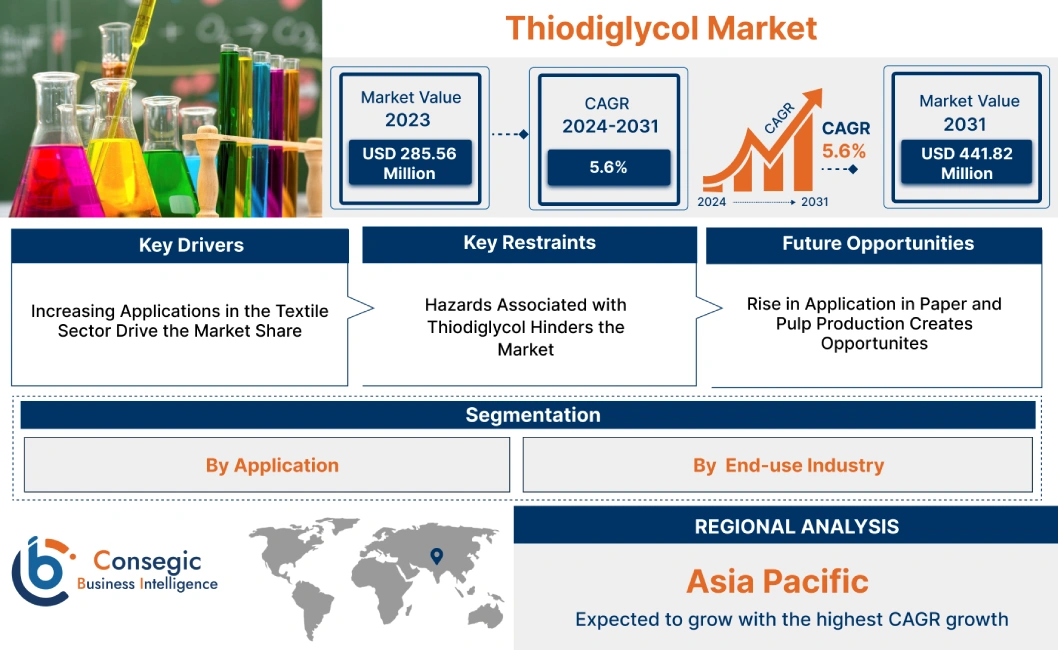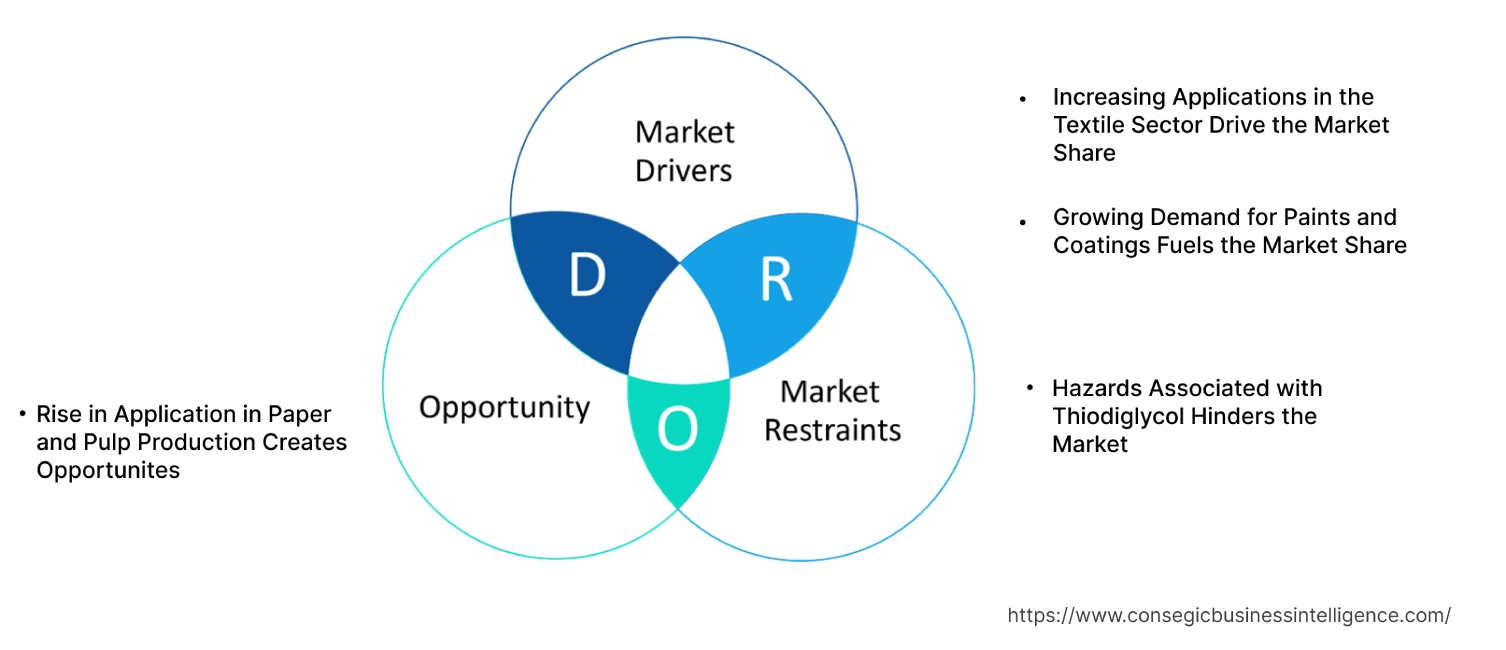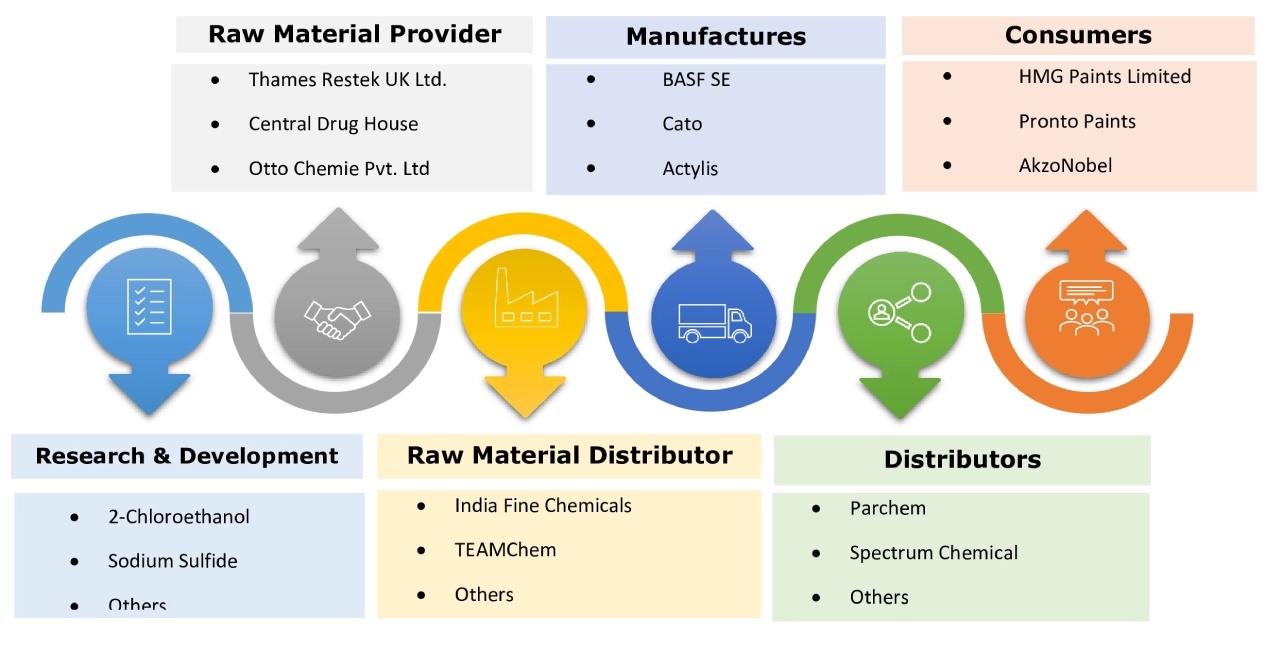- Summary
- Table Of Content
- Methodology
Thiodiglycol Market Size:
Consegic Business Intelligence analyzes that the thiodiglycol market size is growing with a CAGR of 5.6% during the forecast period (2024-2031). The market accounted for USD 285.56 Million in 2023 and USD 296.49 Million in 2024, and the market is projected to be valued at USD 441.82 Million by 2031.
Thiodiglycol Market Scope & Overview:
Thiodiglycol is a colorless, odorless liquid chemical compound with the formula HSCH2CH2OH. The compound is a member of the glycol family, containing a sulfur atom in its structure. This compound possesses several key characteristics that make it valuable in various industrial applications. Primarily, the compound is utilized as a solvent due to its ability to dissolve a wide range of substances, including oils, resins, and dyes. Solvent properties of thioglycol are useful in industries such as textiles, printing, and ink manufacturing.
Additionally, based on the analysis, this compound also serves some niche applications in the formulation of specialty chemicals and as a component in certain types of coatings, particularly those used in the chemical and automotive industries. Proper handling, storage, and disposal protocols are crucial due to their toxicity, emphasizing the importance of adhering to safety guidelines when utilizing this compound in various applications.
Thiodiglycol Market Insights:
Key Drivers:
Increasing Applications in the Textile Sector Drive the Market Share
Thiodiglycol is increasingly utilized in the textile sector for various applications. Its primary role is as a solvent in dyeing processes, enhancing the solubility and effectiveness of dyes. This compound also acts as a softener, improving the texture and feel of fabrics, which is crucial for consumer satisfaction. Moreover, derivatives of this compound are being explored for their potential in developing specialized textile auxiliaries, which enhance fabric properties such as water resistance and durability. The growing trend towards sustainable and eco-friendly textiles has also led to an increased interest in this compound, as it is biodegradable and has a lower environmental impact compared to traditional solvents. As the textile sector continues to innovate, the requirement is expected to rise, driven by its versatility and effectiveness in improving textile quality and performance.
- For instance, according to the data published by the UK Fashion and Textile Association in November 2023, stated that the UK fashion and textile sector contributes around USD 67.48 billion of the total UK GDP.
Thus, the aforementioned factors are propelling the expansion of the market.
Growing Demand for Paints and Coatings Fuels the Market Share
The requirement for more paint and coating solutions is boosting the use of this compound further driving the market. In the paint and coating sector, the compound serves as an indispensable compound for certain resins and binders used in paint formulations. TDG acts as a solvent in resins allowing for a smoother application, improved film formation, and better adhesion of the paint to the substrate. Additionally, TDG also acts as a coalescing agent and plasticizer, helping dispersed polymer particles in the paint to merge and form a continuous film upon drying and preventing cracking of the paint film. This improves the overall film properties and performance of the coating. TDG is a building block in the preparation of an electrodepositable sulfonium group-containing epoxy resin. Such coatings improve exposure durability and color stability.
Moreover, these paints and coatings are widely employed in various industries including construction, automobiles, and textiles. The rising automobile manufacturing is increasing the requirement for paints and coatings further boosting the requirement.
- For instance, according to the report published by the Germany Trade and Invest in February 2023, German passenger car and light commercial vehicle OEM generated foreign market revenue of almost USD 302.47 billion in 2021 which is a 10 % increase from 2020.
Thus, the growing requirement for paints and coatings is influencing the expansion of the market.
Key Restraints :
Hazards Associated with Thiodiglycol Hinders the Market
Disadvantages associated with the utilization of thiodiglyol are significantly hampering the market. This compound is known to be toxic, posing health hazards upon exposure through inhalation, ingestion, or skin contact. It can irritate the skin, eyes, and mucous membranes. Prolonged or repeated exposure leads to more severe health issues and organ damage. Additionally, improper disposal or release of this compound into the environment causes adverse effects to aquatic life and contaminates soil and water sources, posing risks to ecosystems.
- For instance, the Organisation for the Prohibition of Chemical Weapons declared thioglycol as a Schedule 2 chemical which is deemed to pose a significant risk of being used as a chemical weapon or may be important for the production of any of the chemicals. Hence, due to its toxic nature, this compound requires stringent handling procedures and strict adherence to safety protocols.
As a result, drawbacks associated with this compound are posing potential challenges to thiodiglycol market growth and trends.
Future Opportunities :
Rise in Application in Paper and Pulp Production Creates Opportunites
In the paper and pulp sector, this compound is widely utilized as a pulping aid, bleaching aid, and a strengthener. As a pulping aid, TDG helps break down the lignin that binds cellulose fibers. Additionally, it aids in removing color from the wood pulp. As a strength, this compound helps to improve the strength of paper. Moreover, the expanding paper and pulp sector is increasing the requirement.
- For instance, according to the data published by the International Energy Organization in July 2023, global paper production reached a record peak of 417 million tonnes in 2021, which is a 4% increase compared with 2020.
As a result, the increase in the production of paper is expected to boost the thiodiglycol market trends for market growth.
Thiodiglycol Market Segmental Analysis :
By Application:
Based on the application, the market is categorized into solvents, ink, antioxidants, dyes, and others.
Trends in the Application:
- The growing trends in chemical manufacturing have driven a surge in demand in various applications such as the preparation of antioxidants.
In 2023, the dyes segment accounted for the highest thiodiglycol market share of 35.14% in the thiodiglycol market.
- This compound serves a significant purpose in the dye segment due to its solvent properties and ability to act as a reducing agent.
- Primary applications of this compound in dyes include solvent, reducing agent, dye formulation, and dye penetration.
- As per the analysis, the is utilized as a solvent in the manufacturing process of certain dyes as an intermediate and aids in achieving the desired consistency and uniformity in dye formulations.
- It assists in the creation of vibrant and fast-coloring dyes by facilitating the reduction of dye precursors.
- These dyes are widely employed in paints required in construction projects.
- Additionally, the increasing investment in construction development in developing countries is boosting the requirement for paints thereby driving the segment growth.
- For instance, according to the data published by the India Brand Equity Foundation in August 2023, the total foreign direct investment in construction development and infrastructure activity sectors in India stood at USD 26.23 billion and USD 28.95 billion, respectively, between April 2000 and September 2022.
- As a result, the growing construction sector is fueling the trends and segment requirements.
The ink segment is expected to hold the fastest CAGR over the forecast period.
- This compound finds occasional use in inks, mainly for its unique solvent properties and ability to adjust the refractive index.
- However, as per the analysis, the compound serves an important role in ballpoint pen ink and specialty inks.
- TDG acts as a solvent for dyes and other ink components in some ballpoint pen inks. Its low volatility helps prevent ink from drying inside the pen.
- Additionally, this compound is also utilized in textile printing inks and marking inks due to its ability to dissolve a wider range of materials.
- Thus, these factors are propelling the trends and expansion of the segment.
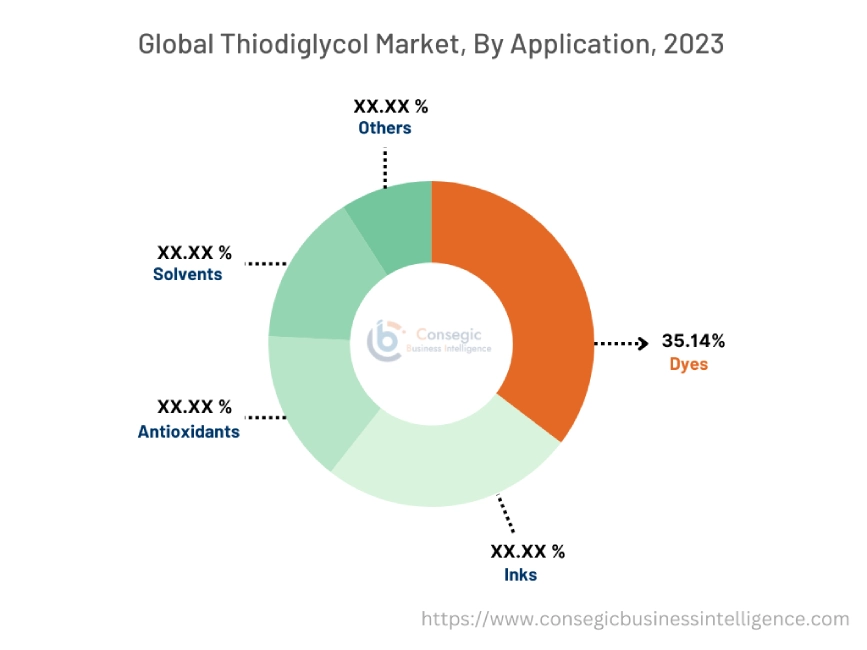
By End-Use Industry:
Based on the end-use industry the market is categorized into paints and coatings, chemicals, paper and pulp, textiles, plastic, cosmetics, and others.
Trends in the End-use Industry:
- The compound is gaining traction as an additive in rubber production, enhancing the performance characteristics of rubber products.
- The agricultural sector is witnessing a rise in the use of thiodiglycol in pesticide formulations, contributing to more effective crop protection solutions.
In 2023, the textile segment accounted for the highest market share in the overall thiodiglycol market.
- In the textile sector, this compound is extensively used as a solvent and finishing agent for fabrics.
- This compound helps achieve desirable properties like softness, color vibrancy, and wrinkle resistance, making it a valuable tool for textile manufacturers.
- Additionally, the booming textile sector in emerging markets is fueling a continuous requirement for TDG in garment production and processing.
- For instance, according to the data provided by the National Investment Promotion and Facilitation Agency, in December 2023, exports value of textiles and apparel including handicrafts in India accounted for USD 44.4 billion in the financial year 2021-22, indicating a substantial increase of 41% FY 2020-21 and 26% FY 2019-20, respectively.
- As a result, based on the analysis, the growing textile sector is creating the thiodiglycol market demand further propelling the segment growth.
The paints and coatings segment is expected to hold the fastest CAGR over the forecast period.
- This compound serves a significant role in the paints and coatings sector as a solvent for resins and binders, coalescing agents, and plasticizers.
- This compound acts as a solvent for certain resins and binders used in paint formulations, particularly alkyd resins and polyurethane resins.
- This allows for a smoother application, improved film formation, and better adhesion of the paint to the substrate.
- Additionally, as per the analysis, water-based coatings, play the role of coalescing agent, helping dispersed polymer particles in the paint to merge and form a continuous film upon drying.
- This improves the overall film properties and performance of the coating.
- Furthermore, the rising requirement for paint and coatings in various industries is expected to increase the requirement and create new opportunities for segment growth.
Regional Analysis:
The regional segment includes North America, Europe, Asia Pacific, the Middle East and Africa, and Latin America.
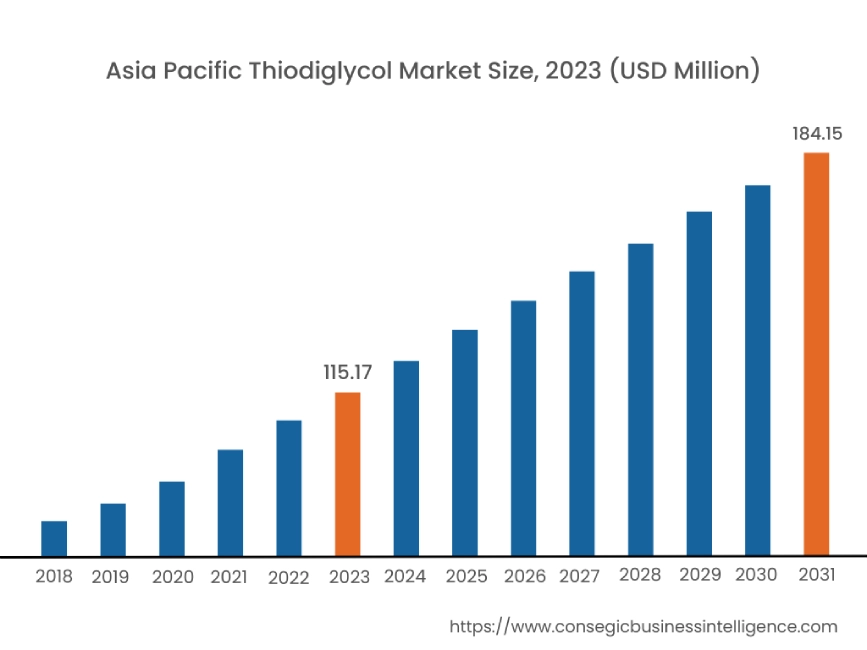
The Asia Pacific region is expected to witness significant growth over the forecast period, growing at a CAGR of 6.0% during 2024-2031. In Asia Pacific, China accounted for a major market revenue of 43.2% in 2023.
The thiodiglycol market across the Asia Pacific region is growing owing to the rapidly expanding industrial sector including paints and coatings, chemicals, paper and pulp, and textiles. Rising disposable incomes in the region are fueling increased consumption of products that rely on this compound for their production, such as dyes, and inks. Additionally, the rising population across the region is boosting the demand for textiles which in turn is boosting the demand for dyes and inks, thereby propelling the market growth potentially. Moreover, based on the analysis, the Asia Pacific holds the largest textile producers in the world.
- For instance, according to the data provided by the U.S. Department of Agriculture, in August 2022, China is the world's largest textile manufacturer and cotton consumer.
As a result, all these above-mentioned factors are collectively driving the demand for this compound in the Asia Pacific region and are expected to create lucrative thiodiglycol market opportunities in the region.
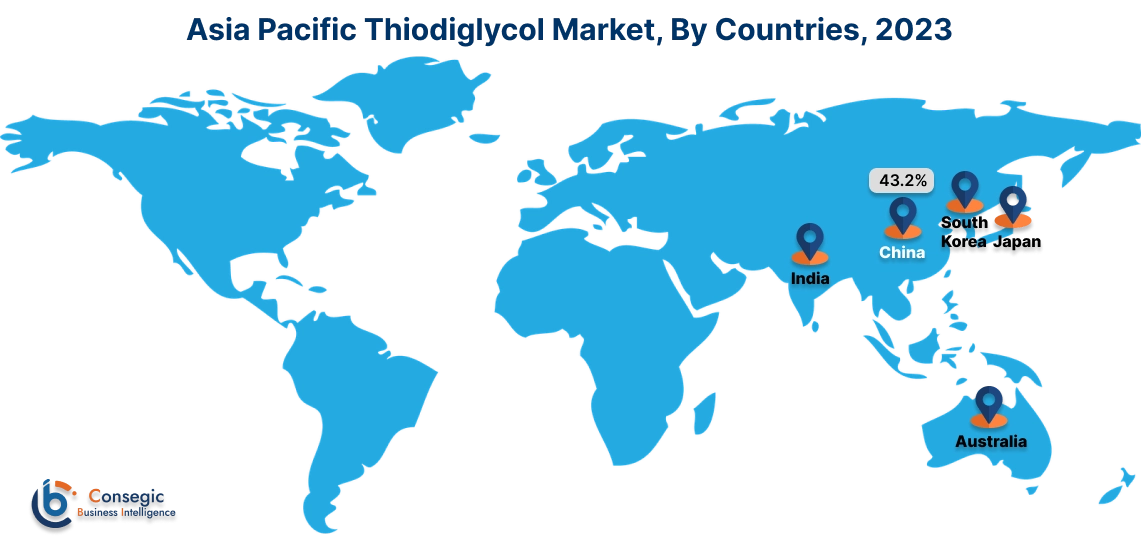
As per the thiodiglycol market analysis, Europe is anticipated to witness substantial growth that is backed by the increasing adoption of this compound in various sectors such as the chemical, and textile among others. Companies invest in innovative technologies to cater to the surging demand for these compounds across the region.
The Middle East, Africa, and Latin America are expected to grow at a considerable rate due to increasing investments in chemical and other sectors in countries like Brazil, and UAE, among others.
Top Key Players & Market Share Insights:
The global thiodiglycol market is highly competitive, with several large players and numerous small and medium-sized enterprises. These companies have strong research and development capabilities and a strong presence in the market through their extensive product portfolios and distribution networks. The thiodiglycol industry is characterized by intense competition, with companies focusing on expanding their product offerings and increasing their market share through mergers, acquisitions, and partnerships. The key players in the thiodiglycol industry include-
- BASF SE (Germany)
- Merck KGaA (Germany)
- HPC Standards GmbH(Germany)
- Ing. Petr Švec - PENTA s.r.o. (Czechia)
- CATO (U.S)
- Actylis (U.S)
- Spectrum Chemical (U.S)
- Benson Polymeric Inc.(U.S)
- MAOMING YUNLONG INDUSTRIAL DEVELOPMENT CO., LTD(China)
- HiMedia Laboratories(India)
Recent Industry Developments :
Business Expansion:
- In May 2023, Organisation for Prohibition of Chemical Weapons (OPCW) opened its chemical lab Centre for Chemistry and Technology (ChemTech Centre). The OPCW will focus on chemical weapon forensics and monitoring the production of dual-use chemicals like thiodiglycol. This is used to make pesticides, mustard gas, and organophosphates.
Thiodiglycol Market Report Insights :
| Report Attributes | Report Details |
| Study Timeline | 2018-2031 |
| Market Size in 2031 | USD 441.82 Million |
| CAGR (2024-2031) | 5.6% |
| By Application |
|
| By End-use Industry |
|
| By Region |
|
| Key Players |
|
| North America | U.S. Canada Mexico |
| Europe | U.K. Germany France Spain Italy Russia Benelux Rest of Europe |
| APAC | China South Korea Japan India Australia ASEAN Rest of Asia-Pacific |
| Middle East and Africa | GCC Turkey South Africa Rest of MEA |
| LATAM | Brazil Argentina Chile Rest of LATAM |
| Report Coverage |
|
Key Questions Answered in the Report
How big is the Thiodiglycol market? +
In 2023, the Thiodiglycol was USD 285.56 million.
Which is the fastest-growing region in the Thiodiglycol market? +
Asia Pacific is the fastest-growing region in the Thiodiglycol market.
What specific segmentation details are covered in the Thiodiglycol market? +
Growth medium, Farm Type, Farming Type, and Crop Type are the segmentation details covered in the Thiodiglycol market.
Who are the major players in the Thiodiglycol market? +
BASF SE, Merck KGaA, Actylis, Spectrum Chemical, HPC Standards GmbH, Ing. Petr Švec - PENTA s.r.o., CATO, Benson Polymeric Inc., MAOMING YUNLONG INDUSTRIAL DEVELOPMENT CO., LTD., and HiMedia Laboratories.
